Helpful hints: how to properly grow melon in a greenhouse
Growing melons in a greenhouse is the only possible way for the northern regions, and this article will help you understand the intricacies of this process, starting from the choice of a variety and ending with harvesting.
Melon belongs to the melon crops, which produces sweet and aromatic fruits. Plants have creeping branching stems. A very thermophilic culture needs good lighting and fresh air. The long growing season and cold intolerance complicate the growing process in areas with a cold climate. Melons do not have time to ripen there. Greenhouses come to the rescue, in which these melons develop successfully and give a tasty harvest.
It will take a lot of work to cultivate melons in a greenhouse, because this culture is demanding on agrotechnical methods. At the same time, the protected greenhouse soil assists in maintaining suitable hydrothermal conditions for melons, which increases the efficiency of melon cultivation.
Content:
- Choosing a melon variety for a greenhouse
- Soil and seed preparation
- Features of planting seedlings of melon
- Growing conditions and care for melons in the greenhouse
- Garter and shaping of melons in the greenhouse
- Diseases, pests and their prevention
Choosing a melon variety for a greenhouse
The advantage of growing melons in a greenhouse is the possibility of obtaining a year-round harvest. If there is not enough space in the room, melons can be planted in unheated greenhouses in summer.
Before proceeding with the cultivation of melons in the greenhouse, you need to decide on the variety of this culture:
- to determine with a variety, the endurance of unfavorable conditions, the ripening time, the taste characteristics of the fruits and the level of yield should be taken into account
- the most suitable varieties for greenhouse conditions can be "Canari", "Charente", "Ogen", "Galia" and the famous "Kolkhoznitsa", which has a rich sweet taste and many fruits in indoor conditions
- grafts are recommended for Central Asian and southern varieties, which increase resistance to cold
- for more northern regions, early ripening varieties should be selected: "Zolotistaya", "Gribovskaya", "Tobolinka", "Skorospelka Sibirskaya" and "Zolotinka". They need to be planted in seedlings, which increases productivity.
Soil and seed preparation
Melon is very demanding on the soil and in order to obtain aromatic sugar fruits, the soil for planting must be prepared in advance. In autumn or spring, the land for the greenhouse is fertilized organic fertilizerswhich include compost, humus or last year's manure (10 kg), superphosphate (40-50 g), potassium salts and nitrate (20-30 g each). In the absence of organic matter, it is permissible to use any baking powder (fine sand, wood shavings, straw seeds), which can suppress the reproduction of fusarians, imperfect molds that pose a particular danger to melons and gourds.
Another option for a greenhouse soil mixture is low-lying peat and fine sand in a 3: 1 ratio, where chalk or dolomite flour (300 g) is added and mineral fertilizer nitrophosphate (40 g).
The optimal amount of fertilization is 10 kg per 1 m2 of soil.
For an earlier harvest, melons are planted in seedlings:
- Seeds pick fresh and pre-soaked in potassium permanganate solution for one hour and germinate by wrapping them in a damp cloth at a temperature of 25 degrees.
- It is recommended to grow the hatched seeds in separate plastic cups or peat pots from 8 cm in diameter.
- The soil mixture for seeds should contain soil and humus in a ratio of 1: 3, 50-60 g of phosphorus, 20 g of nitrogen and potassium fertilizers.
- Seed material is buried in the ground by 2-3 cm and covered with polyethylene until germination. There are two seeds for each pot.
- For germination, seeds require a temperature of at least 23 degrees and 12-14 hours of lighting per day. Lack of daylight is compensated by fluorescent lamp.
- After the first shoots appear, the polyethylene shelter is removed. Weakened boring removes, but strong seedlings leave until a couple of full-fledged leaves appear.
Features of planting seedlings of melon
For planting seedlings holes are prepared in advance according to the scheme 40x40 or 45x45 cm, on the bottom of which humus or compost (0.5-1 kg) is placed and mineral fertilizer (15g). Sprinkle on top with a layer of soil (20 mm) and spill it with a weak manganese solution.
Before planting, the sprouts are plentifully spilled and carefully removed from the seedling containers along with a lump of soil and placed in the holes 4 sprouts, placing a shallow container with water in the center, add the plants, sprinkle them again with non-cold water and sprinkle with mulch from the calcined sand.
It is important that the seedlings protrude three centimeters above the ground.
To help the seedlings quickly adapt and take root, it is recommended to place a film cover over the bed, which is stretched on arcs or attached to pegs. It is removed when the seedlings take root and grow. After the appearance of the fifth leaflet, you need to pinch the plants, removing the growth point, for the formation of adventitious lashes, the weakest of which are cut off. When watering the sprouts, care must be taken to keep the foliage and shoots dry.
Growing conditions and care for melons in the greenhouse
Melon is a very thermophilic culture, so its transplant they begin to enter the greenhouse after the greenhouse soil warms up to 15 degrees 10 cm deep. The temperature is 24-29 degrees, and during the ripening period of dessert vegetables, a daily temperature of 29-40 degrees is recommended.
For uniform illumination, vertical trellises should be installed in the greenhouse. At the same time, the melon lashes will be less in contact with the soil, which will reduce the risks of fungal and bacterial infections. On top of each row, at a height of 1.5-2 meters, two wires are pulled with an interval of 20 cm and the lashes of the plant are directed at them.
During flowering and the formation of ovaries, the humidity in the greenhouse must be maintained at a level of 70-80%, which must be reduced during the period of fruit ripening.
Humidity control is carried out by airing (opening or closing the vents) and carrying out refreshing watering. A non-woven fabric stretched under the roof will help to avoid the accumulation of condensation, which will help to contain dripping and evaporating moisture.
Watering melon seedlings:
- In greenhouse conditions, the melon does not have the opportunity to receive moisture from precipitation, therefore it is necessary to carry out watering plants.
- Melons tolerate soil drying well enough and do not like waterlogging.
- Before the appearance of flowers, it is recommended to irrigate the crop after the topsoil dries out or with a slight wilting of the foliage.
- During flowering and the formation of ovaries, the requirement for watering increases by 1.5-2 times.
- For fruit ripening, the volume of water is reduced to 0.5 liters per day per bush.
- Excessive watering will lead to watery fruit and loss of flavor. The highest sugar content and aroma is achieved under hot conditions with minimal watering.
Melon feeding in the greenhouse:
- Timely complex feeding (nitrogen + potassium + phosphorus) is of great importance for a good harvest.
- The first top dressing bring in after the formation of the primary leaf. The second - after one and a half to two weeks from transplanting seedlings into greenhouses.
- For a young plant, a top dressing is prepared by mixing ammonium nitrate (1 g), superphosphate (2 g) and potassium chloride (1.5 g).
- You can use ready-made complex mixtures, which must be diluted with water according to the instructions.
- During flowering, nitrogen supply is reduced, which promotes the growth of greenery, and is not required for fruits. Once every two weeks, potassium-phosphorus fertilizers are applied with irrigation water.
Garter and shaping of melons in the greenhouse
Tying seedlings to the trellis begins on the fourth day after planting. It is performed in a checkerboard pattern (one bush goes to one wire, the second to another). The twine is tied around the first leaf and secured with a sliding knot on the wire. When growing up, the lash needs to be wound around the twine from left to right.
Greenhouse melons are formed into two wattle fence, which are fixed on the trellis, and the excess shoots are removed. The side stems are pinched after the fourth leaf above the vegetable, and the main lash - at the moment the wire reaches the level.
To obtain a good harvest, up to six ovaries are left on one whip of small-fruited melons, and up to two in large-fruited, the remaining fruits are removed.
After harvesting, the formation of secondary fruits is possible, but the likelihood of their complete ripening is low. It is recommended to place each fruit in a nylon mesh, which is fixed on a trellis, because they get heavy and can break off early under their own weight. Under the melons that lie on the ground, put plywood and a board to prevent rotting.
In greenhouse conditions, pollination of flowers is difficult, therefore, when flowering all doors and vents should be opened to provide access for insects. You can lure them with the help of melliferous plants or spray the supports of the greenhouse with sweet water. If insects do not fly due to bad weather, then pollination must be carried out manually. The procedure is carried out between nine and ten in the morning. It is necessary to collect the opened male inflorescences and attach the stamens to the stigma of the female flower. Moreover, to pollinate one female flower, you will need several male ones.
Diseases, pests and their prevention
Melons growing in greenhouses are not immune from diseases and defeat pests, of which the following are common:
- The spot is olive. Irregular brown spots appear on the foliage, and ulcers appear on the stems of the shoots. Oil spots appear on the fruits, which pass into the ulcerative stage and greenish mushroom spores are formed. A liquid of a jelly-like consistency appears between the affected and whole tissues. Melons lose their presentation, and the ovaries die.
- Powdery mildew... All parts of the plant are covered with a terry whitish bloom. When the form is neglected, the plant sheds foliage and the fruits are affected.
- Anthracnose. The leaves are covered with large yellowish spots, and on the whips and melons there are sores with a pink crust. When the roots are damaged, the plants die. Excess moisture can be the cause of the disease.
- The most dangerous pest are spider mites and aphid, which feed on plant sap and, as a result of their vital activity, entangles foliage and shoots with sticky cobwebs. With their invasion, the melon bushes die. Chemicals are used against diseases and harmful insects according to the instructions.
Preventive measures are:
- maintaining the cleanliness of the greenhouse and the area around them
- placement at the entrance of a sawdust path impregnated with a composition of salt, formalin and bleach
- the base and upholstery of greenhouses are treated with manganese composition
The maturity of greenhouse melons is determined by the color of the peel, the relief of the netting, aroma and ease of separation from the stalk. The average fruit ripening period is 1-2 months. If you overexpose melons on lashes, they can crack.The taste of the pulp directly depends on the quality of agricultural technology and environmental conditions.
More information can be found in the video:




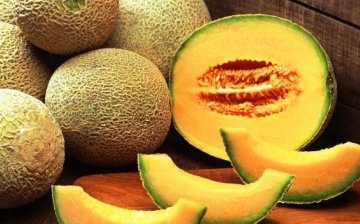
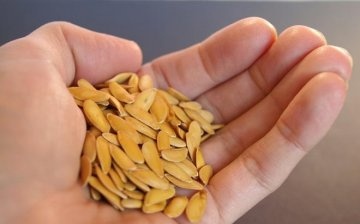
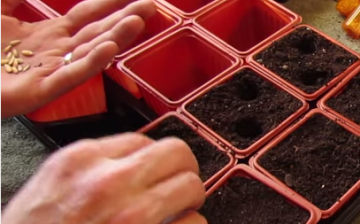
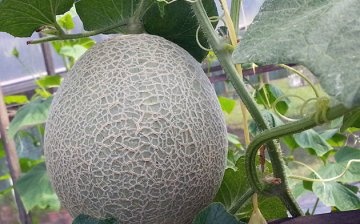

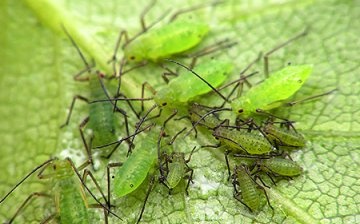







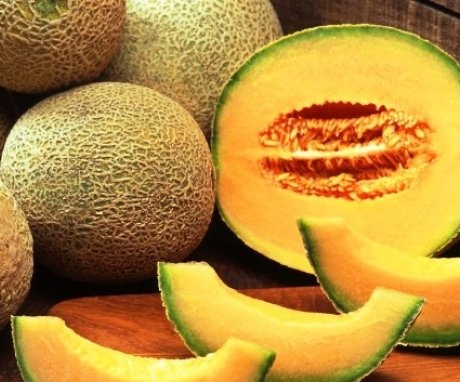
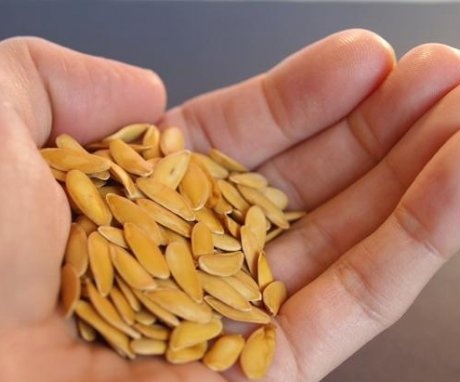
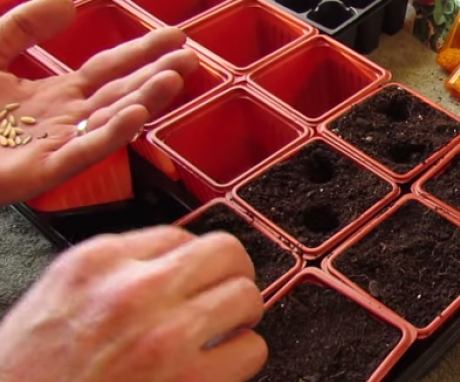
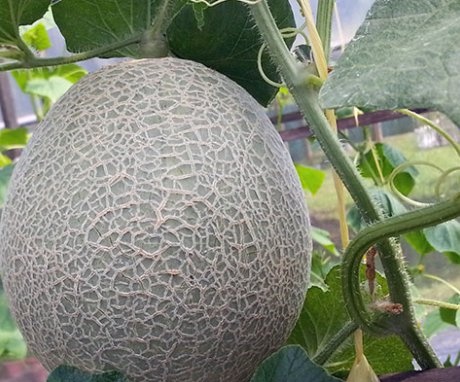
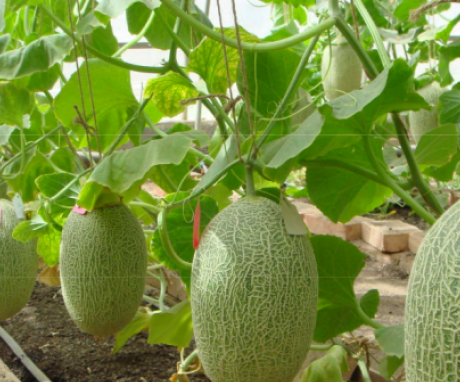
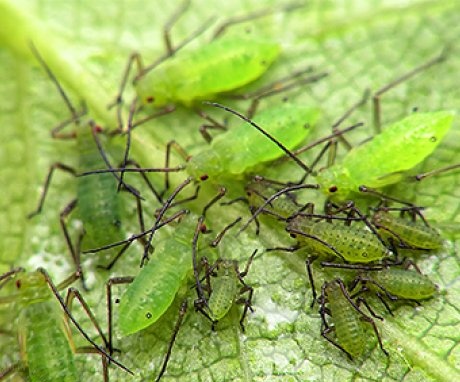
For a very long time, I grew melons outside the greenhouse, but when ripe, they were absolutely not sweet and not juicy. I didn't even think about planting them in greenhouses, next year I will definitely try this method! I will very much hope for a positive result.
I really like to tinker with melons, but I do it outdoors in the summer. In a greenhouse, it is rarely possible to get at least some kind of harvest, while a lot of effort is spent on creating the minimum acceptable conditions.